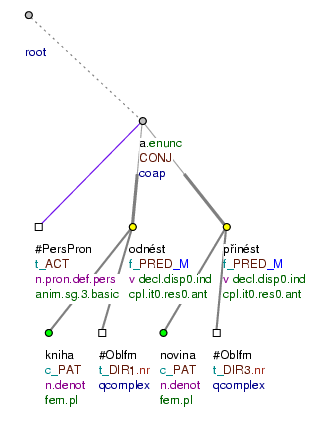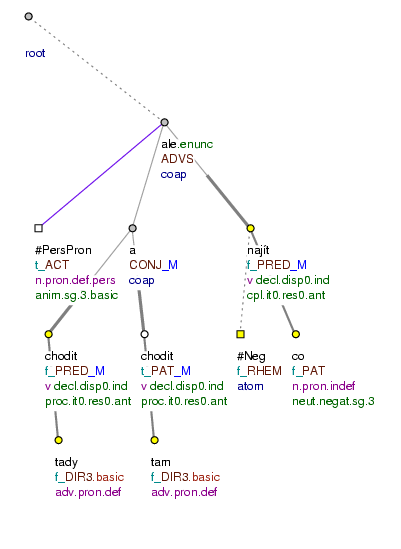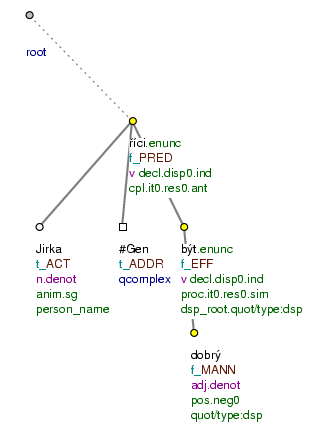This section deals with relationships between clauses in relation to topic-focus articulation. We focus especially on the relationships between clauses in compound (paratactic) sentences (see Section 4.3.2, "Topic-focus articulation of paratactic structures") and in complex (hypotactic) sentences (see Section 4.3.3, "Topic-focus articulation of dependent verbal clauses"), and on the annotation of the first sentence of a text (see Section 4.3.1, "Topic-focus articulation of the first sentence of a text").
General guidelines for the annotation of paratactically and hypotactically connected clauses can be found in Section 4, "Verbal and non-verbal clauses" and Section 5, "Dependent verbal clauses", respectively.
As for the annotation of the topic-focus articulation, the guidelines for paratactically connected independent clauses (i.e. compound sentences) differ substantially from the guidelines for clauses in dependency relation (i.e. complex sentences). There are, however, some exceptional cases of hypotactically connected sentences that are on the borderline between both types of complex sentences from the semantic point of view.
When annotating the first sentence of a text, we cannot count upon its connection to the preceding text. We take for granted that the speaker starts the sentence with those expressions that he supposes the addresse will start from, and thus establishes them as the topic.
Nodes representing expressions directly dependent on the governing verb of the first sentence of a text that stand before the verb in surface word order are therefore assigned the tfa value t or c.
Also headlines are considered to be first sentences of a text provided they are expressed as verbal clauses.
The sentence following immediately after a headline is annotated as the second sentence of a text if it connects immediately and clearly to the headline; if the connection between its topic-focus articulation and the headline is unclear, we determine the contextual boundness of its expressions as if it were the first sentence of the text. Compare:
-
(Dnešní zasedání sněmovny.) Na dnešním [
tfa=t] zasedání [tfa=t] sněmovny [tfa=t] předložili [tfa=f] ... (=lit. (Today's session of_parliament) On today's session of_parliament (they) introduced...)The second clause connects to the preceding headline, it is therefore annotated as the second sentence of the text.
-
(Dnešní zasedání sněmovny.) Vládní [
tfa=t] poslanci [tfa=t] předložili [tfa=f] na dnešním [tfa=t] zasedání [tfa=f] sněmovny [tfa=f] ... (=lit. (Today's session of_parliament) Government MPs introduced on today's session of_parliament...)The second does not connect clearly to the preceding headline, it is therefore annotated as the first sentence of the text.
Paratactic structures get a specific treatment in the tectogrammatical annotation (see Section 6, "Parataxis") and some additional guidelines concerning the annotation of their topic-focus articulation are required as well. When annotating paratactic structures, we adopt the following principles:
-
the root of a paratactic structure is not assigned any
tfavalue. The root of a paratactic structure is placed centrally between the direct members of the paratactic structure. -
the attribute
tfais not filled for nodes with the functorCMeither (i.e. nodes representing conjunction modifiers; see Section 16.1, "Co-ordinating connectives"). Nodes with the functorCMstay in the underlying order in a position parallel to that in the surface word order. -
the effective root of a shared modifier (i.e. the whole subtree) of a paratactic structure is placed as the leftmost direct dependent of the root of the paratactic structure if the effective root of the shared modifier is contextually bound; if the effective root of the shared modifier is contextually non-bound, it is placed as the rightmost direct dependent of the root of the paratactic structure.
Compare:
-
Ten nůž má nerezovou [
tfa=f] čepel [tfa=f] i rukojeť [tfa=f] (=lit. That knife has stainless_steel blade and_also grip.)In the tectogrammatical tree, the node representing the contextually non-bound shared modifier nerezový (=stainless_steel) is placed as the rightmost direct dependent of the root of the paratactic structure (i.e. the right sister of the node representing the modification rukojeť (=grip)). Cf. Fig. 10.19.
If there are more than one shared modifier, the guidelines for the ordering of nodes in verbal groups apply (if verbs or adjectives are connected; see Section 3.2, "Ordering of nodes in verbal groups (verb phrases)"), or the guidelines for the ordering of nodes in nominal groups apply (if nouns are connected; see Section 3.3, "Ordering of nodes in nominal groups (noun phrases)").
-
Figure 10.19. Topic-focus articulation of paratactic structures
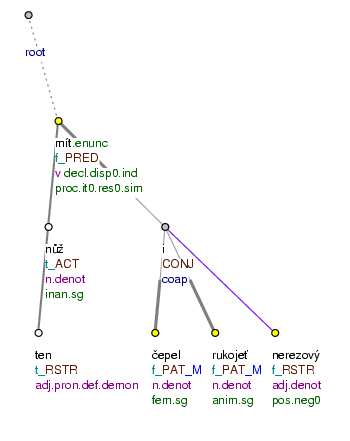
Ten nůž má nerezovou čepel i rukojeť. (=lit. That knife has stainless_steel blade and_also grip.)
A paratactic connection of dependent modifications or clauses is a single unit in the topic-focus articulation of the sentence. As a single unit, it is either contextually bound or non-bound. With the only exceptions stated below, the terminal members of a paratactic structure have the same tfa value.
Exceptions. The only exceptions are the cases when the governing node of a paratactically connected modification (represented as a terminal member of the paratactic structure) is repeated verbatim and cases of ellipsis in paratactic structures (see Section 12.1, "Ellipsis of the governing element"). In these cases, the second governing node of a paratactically connected modification (and possible further governing nodes) is always contextually bound (even if the first member is elided).
Compare:
-
Chci bydlet [
tfa=f] ve státním [tfa=f] bytě [tfa=f] , nebo v družstevním [tfa=f] bytě [tfa=t] (=lit. (I) want to_live in (a) state flat or in (an) associated flat.)The node representing the second governing member of the paratactically connected modification has the
tfavaluetbecause it is the verbatim repetition of the first governing node of the paratactically connected modification.
Different values of the tfa attribute for the terminal nodes of a paratactic structure means different contextual boundness within the paratactic structure. The contextual boundness of the paratactic structure as a whole is represented by the tfa value of the node representing the first governing member of the paratactically connected modification (i.e. the first terminal member). If the first (even non-expressed) governing member of a paratactically connected modification is contextually non-bound, we consider the whole paratactic structure to be contextually non-bound etc.
Paratactically connected independent clauses are considered to have separate topic-focus articulations. Expressions in the second clause may be contextually bound with respect to the preceding clause (if they are repeated or connect to expressions in the first clause).
The effective roots of paratactically connected independent clauses can have differing tfa
Examples:
Tom [tfa=c] přinesl [tfa=f] knihy [tfa=f] a pak [tfa=t] Jirka [tfa=c] odnesl [tfa=f] noviny [tfa=f] (=lit. Tom brought books and then George carried_away newspapers.) Fig. 10.20
Knihy [tfa=c] odnesl [tfa=f] a noviny [tfa=c] přinesl [tfa=f] (=lit. Books.ACC (he) carried_away and newspapers.ACC (he) brought.) Fig. 10.21
Chodil [tfa=f] sem [tfa=f] a chodil [tfa=t] tam [tfa=f] , ale nenašel [tfa=f] nic [tfa=f] (=lit. (He) walked hence and (he) walked forth but (he) did_not_find anything.) Fig. 10.22
Figure 10.20. Topic-focus articulation of paratactically connected independent clauses
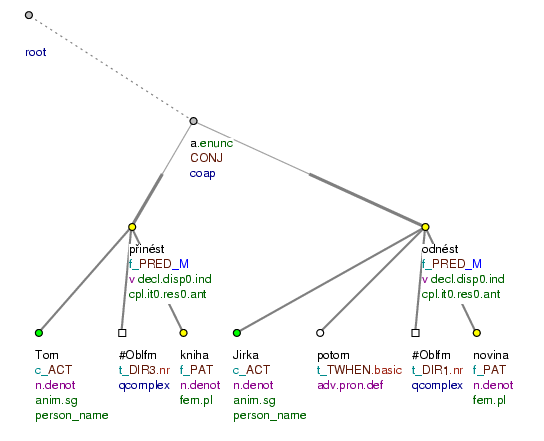
Tom přinesl knihy a pak Jirka odnesl noviny. (=lit. Tom brought books and then George carried_away newspapers.)
Clauses in the relationship of dependency (hypotactic, complex sentence) are usually annotated according to the surface word order (see Section 1.1, "Surface word order"): if the dependent clause stands to the left from its governing verb, the node representing the governing predicate of the dependent clause is assigned the value t and the whole subtree stays on the left; if the dependent clause stands to the right from its governing verb, the node representing the governing predicate of the dependent clause is assigned the value f and the whole subtree stays on the right.
Dependent adverbial clause . However, during the process of annotation we discovered that certain complex sentences with adverbial dependent clauses, especially causal and temporal, behave as paratactically connected compound sentences from the point of view of topic-focus articulation. The information contained in a dependent clause (especially when it is to the left from the main clause) introduces an event so independent from the event of the governing clause from the point of view of their contextual boundness that it can very hardly be interpreted as a bound or non-bound part of the main clause (see also Section 6.2, "Coordination and apposition"). For this reason, we introduced more detailed guidelines for the annotation of topic-focus articulation for dependent adverbial clauses:
-
if a dependent adverbial clause introduces a relatively independent event and it comes before the governing clause for semantic reasons (temporal or causal succession), the subtree of the dependent clause stays to the left from its governing node and the effective root of the dependent clause is assigned the
tfavaluef. Compare:-
Jestliže se nám podaří [
tfa=f] zasadit strom, můžeme se těšit [tfa=f] na jablka. (=lit. If _ we manage to_plant (a) tree, we can look_forward to apples.)The effective root of the dependent adverbial clause is placed to the left from its governing node, even though its
tfavalue isf. Cf. Fig. 10.23.
This is one of the exceptions from the basic guidelines for the ordering of nodes at the tectogrammatical level (see Section 3.1, "Basic guidelines for the ordering of nodes in a tectogrammatical tree").
-
-
if a dependent adverbial clause comes before the governing clause and it is in a contrastive position (it carries a contrastive stress; see Section 1.2.2, "Contrastive stress"), the effective root of the dependent clause is assigned the
tfavaluecand stays to the left from its governing node in the tectogrammatical tree. Compare:-
Protože se program osvědčil [
tfa=c] v zahraničí, použili [tfa=f] ho. (=lit. Because _ (the) program proved_good _ abroad, (they) used it.)The effective root of the dependent adverbial clause is assigned the
tfavaluecand is placed to the left from its governing node. Cf. Fig. 10.24.
In case of doubt the latter guideline has precedence over the former one.
-
!!! There remains as an unresolved issue the problem of determining a well defined borderline between annotating dependent clauses as modifications of the main clause and annotating them as stand-alone communicative units.
Figure 10.23. Topic-focus articulation of dependent adverbial clauses
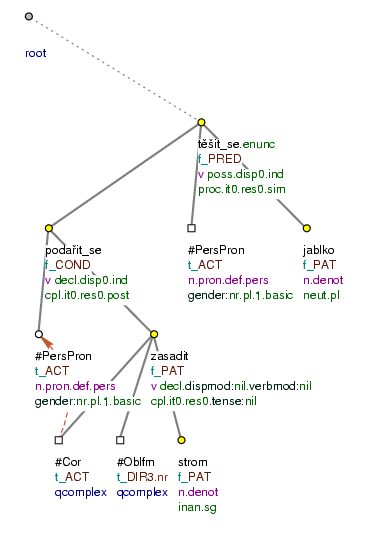
Jestliže se nám podaří zasadit strom, můžeme se těšit na jablka. (=lit. If _ we manage to_plant (a) tree, we can look_forward to apples.)
Figure 10.24. Topic-focus articulation of dependent adverbial clauses
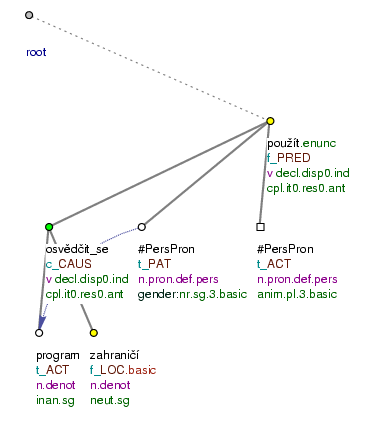
Protože se program osvědčil v zahraničí, použili ho. (=lit. Because _ (the) program proved_good _ abroad, (they) used it.)
Direct speech introduced by a verb . The following guidelines apply to constructions with direct speech introduced by a verb (see Section 3.1.1, "Direct speech as the argument of a verb"):
-
direct speech is usually more communicatively dynamic than the reporting clause (except in cases where the reporting clause contains the focus proper).
Examples:
Jirka [tfa=c/t] řekl [tfa=f/t] "Je [tfa=f] dobře [tfa=f] ." (=lit. George said, "(It) is good.") Fig. 10.25
"Je [tfa=f] dobře [tfa=f] , " řekl [tfa=f/t] Jirka [tfa=c/t] (=lit. "(It) is good," said George.)
Taky [tfa=f] JIRKA [tfa=f] řekl [tfa=t] : "Je [tfa=t] dobře [tfa=f] ." (=lit. Also George said, "(It) is good.")
